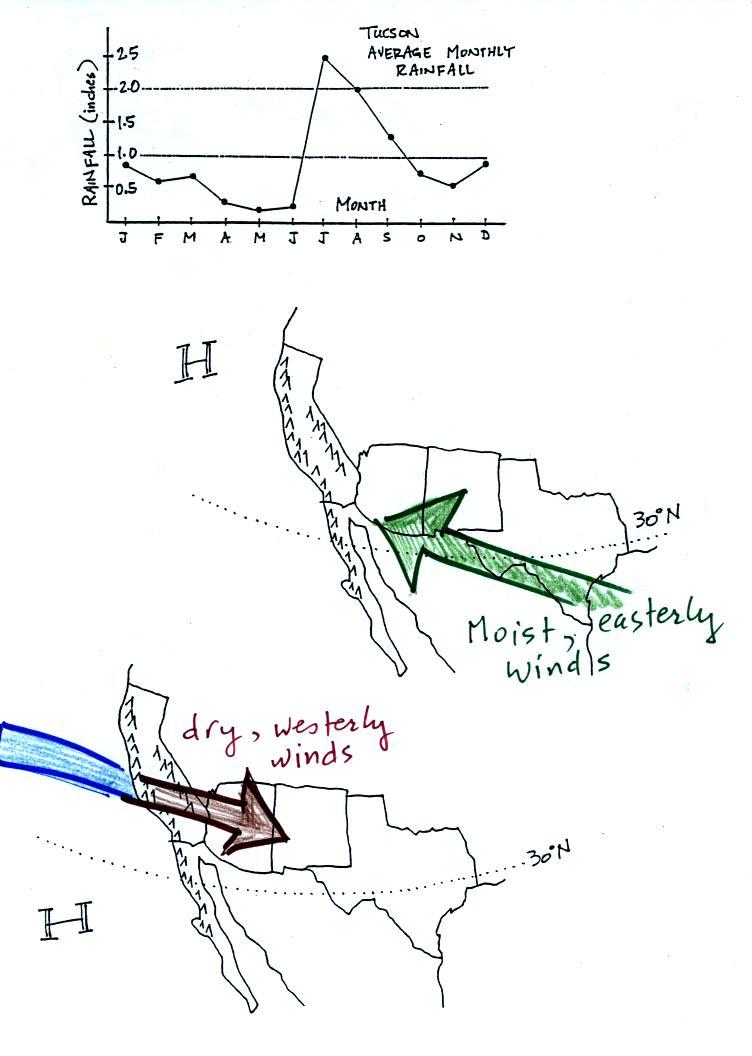There's a lot of information on this picture, but
with a little study you should be able to start with a blank
sheet of paper and reproduce this figure. I would suggest
starting at the equator. You need to remember that there
is a belt of low pressure found there, the equatorial low
(pressure belt). Then remember that the pressure belts
alternate: low pressure at the equator then belts of high
pressure at 30 N and 30 S.
Let's start at 30 S. Winds will begin to blow northward
from High pressure at 30 S toward Low pressure at the equator
(also southward toward low pressure at 60 S latitude).
Once the winds start to blow they will turn to the left because
of the Coriolis force. Up at 30 N winds will also blow
southward toward the equator. They are bent to the right
(you need to turn the page upside down and look in the direction
the winds are blowing). These winds just north and south
of the equator are the Trade
Winds (northeasterly trade winds north of the equator
and southeasterly trades south of the equator). They
converge at the equator and the air there rises (refer back to
the crossectional view of the 3-cell model). This produces a
band of clouds that you can often see at or near the equator on
a satellite
photograph.
The Intertropical Convergence Zone or ITCZ is another name
for the equatorial low pressure belt. This
region is also referred to as the doldrums because it is a
region where surface winds are often weak. Sailing ships
would sometimes get stranded there hundreds of miles from
land. Fortunately it is a cloudy and rainy region so
the sailors wouldn't run out of drinking water (they might well
have run out of rum though).
Hurricanes form over warm ocean water in the subtropics
between the equator and 30 latitude. Because winds at
these latitudes have a strong easterly component, hurricanes, at
least early in their development, move from east to west.
Middle latitude storms found between 30 and 60 latitude, where
the prevailing westerly wind belt is
found, move from west to east.
You find sinking air, clear skies, and weak surface winds
associated with the subtropical high pressure belt at 30 N and
30 S. This is also known as the horse latitudes.
Sailing ships could become stranded there also. Horses
were apparently either thrown overboard (to conserve drinking
water) or eaten if food supplies were running low (Wikipedia
has a different explanation of the origin of the term "horse
latitudes"). Some of the hottest and driest locations on
earth are found near 30 latitude (Tucson is located at 32 N
latitude, so we are strongly affected by the subtropical high
pressure belt).
The winds to the north of 30 N and to the south of 30 S are
called the "prevailing westerlies." They blow
from the SW in the northern hemisphere and from the NW in the
southern hemisphere. The 30 S to 60 S latitude belt in the
southern hemisphere is mostly ocean. Because there is less
friction over the oceans, the prevailing westerlies there can
get strong, especially in the winter. They are sometimes
referred to as the "roaring 40s" or the "ferocious 50s" (the 40s
and 50s refer to the latitude belt they are found in).
Here's a sketch of surface
features found from about 15 N to 75 N laitude.
Winds blowing north from H
pressure at 30 N toward Low pressure at 60 N turn to the right
and blow from the SW. These are the "prevailing
westerlies." The polar easterlies are cold winds
coming down from high pressure at the north pole. The
subpolar low pressure belt is
found at 60 latitude. This is also a
convergence zone where the cold polar easterly winds and the
warmer prevailing westerly winds meet. Because the air
masses south and north of 60 latitude are so different, the
boundary between these two different kinds of air is called
the polar front and is often drawn as a stationary front on
weather maps. A
strong current of winds called the polar jet stream
is found overhead. Strong middle latitude storms will
often form along the polar front.
Here's a map that shows all of the 3-cell model surface
features

This is the same figure
included on the Quiz #4 Study Guide. With a little
practice you should be able to start with a blank sheet of
paper and reproduce this figure. Concentrate on the
features found between 45 S and 45 N latitude (everything
inside the dotted lines)










